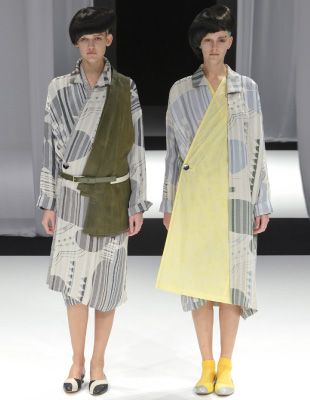
     
     
     
|
 |
織部とは慶長期を代表する陶器のスタイルです。武士で茶の宗匠の古田織部の好みを反映したと言われ、それまでのストイックでミニマムな茶道の美学を打ち破る前衛的なデザインでした。茶碗は強烈にゆがみ、抽象絵画のような楽しい絵付けが器の上を自由に踊り、黒やグリーンの釉薬が大胆にかけ分けられます。織部が目指したのは、静寂と心地よい緊張感の中にも、明るく楽しい遊び心を織り込むことでした。それは生きる歓びを人々と分かち合う「心に残る遊びの時間」を創造するためでした。
matohu「慶長の美」コレクションの最初と最後のテーマは「織部」ですが、それはこの陶器が400年前の日本の美意識を体現するだけでなく、matohuのコンセプトそのものでもあるからです。
このコレクションでは織部焼そのものにとらわれず、明るくビビッドな色合いとゆがんだシェイプ、グラフィカルなプリント柄などでスポーティーで軽やかな「織部」のエッセンスを表現しています。
" Oribe" is a style of pottery representative of the Keicho Period (1596-1615). It is said that the style reflects the taste of Furuta Oribe, who was a Samurai and one of the principal pupils of the great tea-ceremony master Sen no Rikyu.
Oribe broke through the boundaries of the aesthetics of his master, which were stoic and minimalist. He aimed at creating a bright, playful atmosphere amidst the stillness and equilibrium of the tea ceremony.
It was in order to create a moment of memorable play, of sharing the joy of life with the guests.
Matohu's first and last themes at "Beauty in the Keicho Period" were both "Oribe". This is because we believe this pottery embodies not only a 400-year-old Japanese sense of beauty, but also our brand concept.
In this collection, rather than focusing on the pottery itself as in the first collection, we strived to recreate the essence of Oribe - an expression of the joy of life, using bright colors, unique cutting and asymmetric shapes.
|
 |


